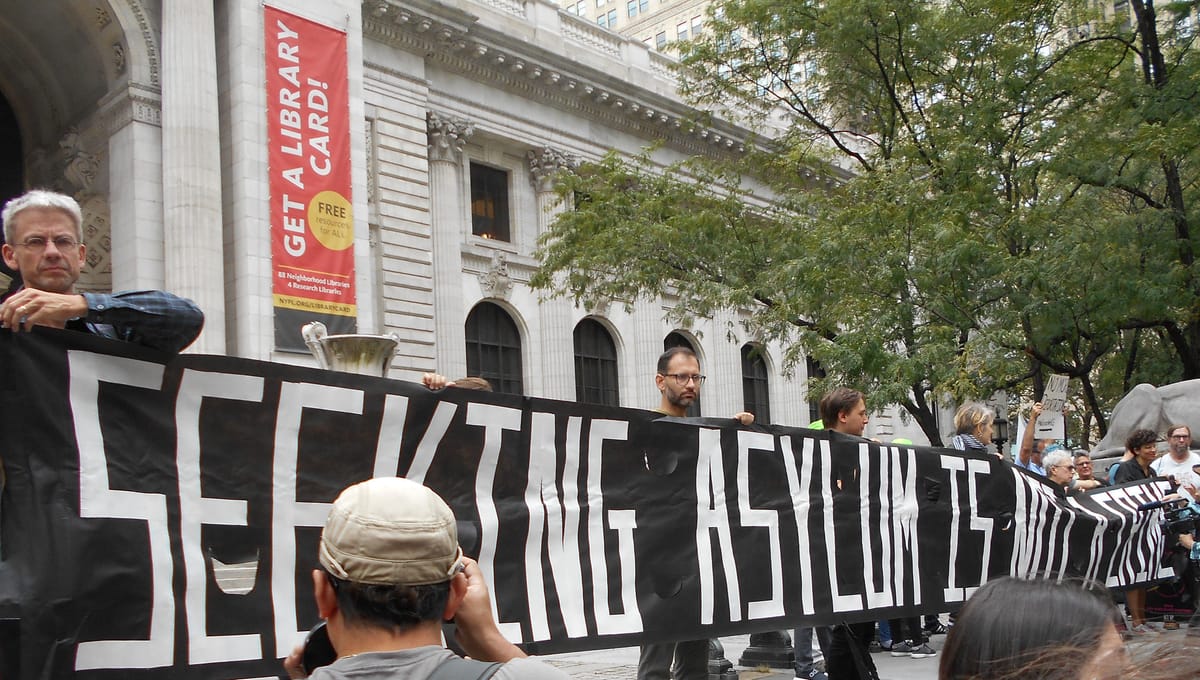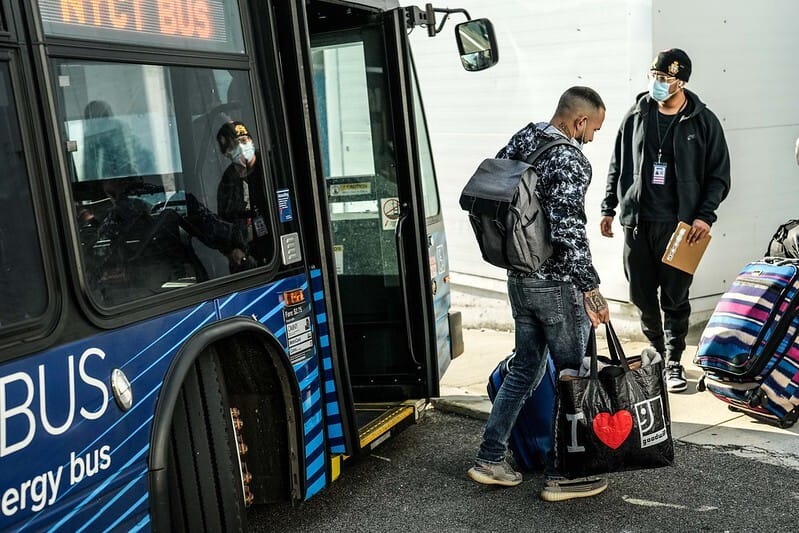The decades-old policy behind New York’s failure on asylum seekers
We've got years of data showing that telling people 'don't come' doesn't work, but policymakers keep doing it anyway.

While many of the questions surrounding the so-called migrant crisis are practical and immediate — where are these folks going to live, can they work, are arrivals being coordinated or sent ad-hoc by opportunistic southern governors — there’s a more abstract question that many New Yorkers are asking: why are these folks showing up here and now?
As much as City Hall and the federal government have bickered over each others’ responses to asylum seeker arrivals, the mutual concern with nipping migration in the bud has been clear, with both Vice President Kamala Harris and Mayor Eric Adams separately making trips to Latin America to tell migrants not to come. Yet as seductive as the idea of simply stopping the flow might be for some policymakers, these and much more heavy-handed tactics haven’t really moved the needle, a marker of how difficult it is to really change the calculus that drives people to migrate. To understand how we got here and exactly why these kinds of policies are so futile, let’s step back and look at the history.
In 2022, Texas began bussing migrants to so-called “sanctuary cities,” including New York. The effort, led by the state’s Republican Gov. Greg Abbott, started as a political stunt — a way of calling out Democrats who had spent the Trump era declaring that “immigrants are welcome here” on their bluff.
In the years since, more than 180,000 asylum seekers have passed through New York City’s intake system, according to the most recent reports. Mayor Eric Adams has repeatedly stated that the city is unable to cope with the strain the influx of new arrivals has put on the shelter system, and recently implemented a 30-day limit for single adult migrants in New York shelters.
Adams, along with Gov. Kathy Hochul, has been sounding the “migrant crisis” alarm for the past two years, and have cited Abbott’s bussing effort and New York’s long-standing right-to-shelter rule as two of the biggest drivers of the so-called crisis. Republicans like Abbott, meanwhile, have attributed the rise in arrivals — both at the border and in New York City — to the Biden administration’s immigration policies.
But it’s not that simple.
It’s true that more asylum seekers have arrived in New York and other cities in the years since Biden was inaugurated than in previous years, if immigration court records are any indication. (According to researchers at Syracuse University, 174,150 cases have been filed in New York immigration courts since the beginning of the 2022 fiscal year, with more than 74,000 filings in 2023 alone.) It’s also true that the increase in the migrant population in New York is related to Abbott’s bussing campaign. These explanations, however, don’t tell the whole story.
The onset of the COVID-19 pandemic kept migrants out of sight
When Texas started bussing asylum seekers to New York in 2022, the situation at the border was a lot different than it is now. At the time, Customs and Border Protection was able to expel most of the migrants encountered at the border under the auspices of a policy called Title 42, which the Trump administration invoked in the early days of the pandemic. Title 42 isn’t technically immigration policy at all; it’s a public health statute that allows the Centers for Disease Control and Prevention to deny entry to certain people at the border to prevent the “introduction or spread” of contagious diseases in the U.S. From the beginning, however, Title 42 was thought of as a border management tool — first by Trump and then by Biden.
Nearly half of the 2.2 million “encounters” U.S. Border Patrol reported during the 2022 fiscal year resulted in Title 42 expulsions, meaning those migrants were returned to Mexico without an immigration hearing. In other words, half of the migrants Border Patrol encountered at the border didn’t make it to the U.S. at all. The other half, however, were processed into the U.S. under Title 8, the section of the U.S. Code that encompasses immigration law. When an unauthorized migrant arrives on U.S. soil, they’re classified as “inadmissible,” meaning they lack the documentation to legally enter the U.S and are put in deportation proceedings.
Asylum is a defense against deportation, but only if someone ends up winning their case. To start the asylum process, a migrant has to show up on U.S. soil and say they’re afraid of returning to their home country. People can’t apply for asylum from outside the U.S. In 2022, in addition to the two million migrants Border Patrol encountered between ports of entry, Customs and Border Protection processed another 147,000 people at ports of entry under Title 8, the vast majority of whom were asylum seekers.
The Biden administration rescinded the Covid-19 public health emergency in May 2023, and Title 42 ended as a result. The problem was that the administration hadn’t exactly prepared for what would come next. Immigration officials rolled out an app, called CBP One, through which migrants could request appointments to ask for asylum at ports of entry. But the app was glitchy and interview slots filled up fast, compounding a bottleneck at the border that had been building up for three years under Title 42. The result was thousands of migrants attempting to enter the U.S. both through official border crossings and between ports of entry, where they often trek through the borderlands for days, or brave the rough waters of the Rio Grande en route to the U.S.
While Title 42 destabilized asylum processing at the border, Covid-19 destabilized the world, contributing to a global migration crisis. In 2022, there were 100 million forcibly displaced people around the world, according to the International Rescue Committee. Most of those people won’t end up in the U.S., or in New York, though many are trying.
Since the beginning of the pandemic, the demographics of people arriving at the border have also changed significantly. Since 1965 and until the early 2010s, most of the unauthorized migrants at the border were from Mexico, and most came to the U.S. in search of work or to reunite with family. The mid-2010s marked the beginning of a Central American migration crisis, as thousands of people — many of them unaccompanied children — fled violence in Guatemala, El Salvador and Honduras. More recently, CBP has reported a significant increase in so-called “extra-continental” migrants, its term for people from Asia, Africa and the Middle East who arrive at our borders in search of refuge. There’s also been a rise in migrants from South America and the Caribbean.
And unlike past waves of asylum seekers, the migrants who have arrived in New York in recent years often lack family or connections in the U.S., which makes it harder for them to get on their feet.

A policy problem decades in the making
Underlying much of our policymakers' response to all this is the notion of deterrence, making it not so that leaving is unnecessary, but coming is untenable. There is some knee-jerk appeal to this idea; if your sense is that too many people are coming with a skewed idea of what to expect, changing that expectation could conceivably dissuade them from making the trek. This notion runs the gamut from targeting so-called “draw factors” like work authorization to outright sadism à la Stephen Miller, perhaps best exemplified by the infamous family separation policy.
Some element of a deterrent strategy has been semi-official U.S. policy for decades, crystalizing in its current form as part of Ronald Reagan’s 1986 amnesty bill, which aside from providing a path to citizenship for millions of people also increased penalties for the employment of undocumented immigrants and tightened up border security. Like much else about the Reagan revolution, it was perfected in the ‘90s by Bill Clinton, who signed a pair of 1996 bills that massively expanded detention and enforcement and closed off multiple avenues to legal status.
Clinton’s turn at the helm also marked the beginning of the “prevention through deterrence” program, an explicitly border-focused initiative to heavily police easier-to-cross areas and drive migrants to less hospitable parts of the border in an effort to dissuade crossings altogether. With the benefit of decades of data, we know this doesn’t work, leading not to fewer crossers but instead to more dead crossers as people succumb to dehydration, drowning and exposure.
What deterrence efforts look like in the real world
In fact, over the many years that deterrence policies have been tried, there’s never been much concrete evidence that they work. Unauthorized immigration flows have ebbed and risen over the years more in tandem with weather and international push factors than any kind of domestic policy, for two main reasons: one, would-be migrants by and large are not following the minutiae of shifting U.S. enforcement policy; and two, the decision to totally uproot your life and traverse thousands of miles to plunge into the unknown, often with your family in tow, is already a phenomenally significant decision. It’s unlikely to be derailed by something as pedestrian as where exactly you’ll cross or whether you’ll have immediate work authorization upon arrival.
This has been true through the militarization of the border, through the post-9/11 border shutdowns and increasing surveillance, through the collapse of multiple “comprehensive immigration reform” deals, through Miller’s successive asylum restrictions, through family separation. In fact, just looking at the data with no context, you might assume an opposite correlation — encounters have only increased despite these efforts.
The lesson seems unlearned given that Democratic officials, including centrist senators and blue-state executives like our own mayor, are now clambering on the dissuasion train. Most of the activist counter-response has taken the form of noting the inhumanity and, in the case of asylum access, potential illegality of overt deterrent efforts, but it’s worth noting, once again, that functionally this approach doesn’t even seem to work.
By the time people have set out, they’ve likely liquidated their possessions and put all their stock in the U.S. Obviously, in asylum cases, the contention is that they cannot return safely at all. They will come, no matter what, particularly as climate cataclysm grows more acute. The only real question is how to handle their arrival.





Comments ()